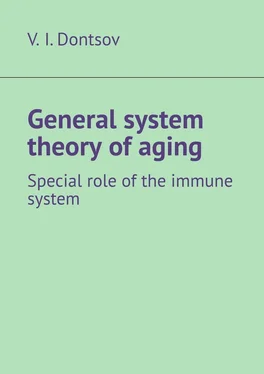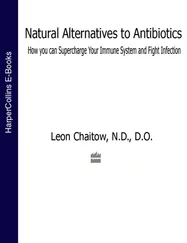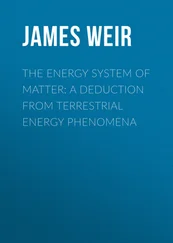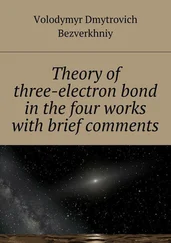Thus, the meaningful interpretation of the concept of “viability” was reduced from the very beginning, and is reduced now, not so much to the material content, but to the energy and information content – to the “entelechy” of the ancients.
For a population of animals or a human cohort, by definition:
μ = dN (t) / N (t),
where N (t) is the number of members of an endangered population at time t . By integrating the Gompertz-Makema equation, one can obtain a direct formula for calculating the number of survivors of a certain age ( formula 4 ):
N (t) =N oexp ((-A t – R o/α (exp (α t) – 1)) (4)
The qualitative view of the survival, mortality and survival curves corresponding to the formulas presented above corresponds to the real survival curves of various human populations, as well as a number of other species. However, the Gompertz-Makema formula describes only the middle part of the mortality intensity curve, whereas the initial part of the curve (growth and development processes – up to 20—25 years) and the final part (older than 80—90 years, individuals with hereditary longevity) cannot be taken into account in this way.
The full mortality curve, which takes into account the period of growth and development and hereditary longevity, can be obtained from the systemic stochastic-regulatory theory of aging discussed below and proposed by us earlier (Dontsov, 1990, 2012, 2017).
The general reason for allowing entropy to work in any system is the principle delimitation of this system from the external one, which does not allow it to fully renew itself and puts a limit to its existence as a separate system.
Similarly, the global cause of aging is the discreteness of the existence of life in the form of individual forms – living organisms, their fundamental limitations (limits of adaptation of all homeostasis mechanisms) in comparison with the almost infinite variety of influences on each particular organism of the rest of the World. The quantitative and qualitative infinity of the effects of the World on a discrete organism can only partially be compensated by homeostasis, which leads to the accumulation of uncompensated damage – the most common mechanism of aging.
Self-renewal of an organism at all its levels is not a sufficient anti-aging factor since the self-renewal process itself is not absolute and has the same random mechanisms.
Some obvious and experimentally and demographically confirmed conclusions are interesting, however, sometimes paradoxically sounding. So from the above, it is obvious that the greatest absolute decrease in viability can be observed at an early age, which we can see from the curves of changes in the ontogenesis of the absolute value of many physiological functions. This means that prevention of aging should begin at the earliest ages. At the same time, in old age, even small absolute changes in viability lead to pronounced changes in mortality, so at older ages, it is convenient to study the effects of adaptogens and biostimulants, although a small vital resource may not lead to a significant increase in life expectancy.
The mathematical analysis of the theories of aging, based on the modeling of its essence – the age-related decline in overall viability, turned out to be surprisingly fruitful and suitable both for objectives of theoretical research and for practical research in population gerontology. At the same time, the common cause of aging is manifested by some general mechanisms that should be modeled and evaluated for their contribution to the overall aging of the system.
Another approach to the quantitative assessment of aging, based on the same definition – reducing overall viability with age, is to consider the overall viability of the system as an integral of the viability of its parts, which, as applied to the body, means that the overall viability of the body consists of maintaining vitality (functional resource) of its main organs and systems ( formula 5).
Х = k 1 х 1+ k 2 х 2+….+k n х n (5)
where k is the coefficient, x1 … n is the viability of organs and systems.
The definition of individual aging as a biological age is based on this.
2.4. Basic global mechanisms: types of aging
2.4.1. The main common mechanisms are types of aging
System analysis allows us to consider aging from several global points of view, thereby revealing the fundamental, general, global mechanisms or types of aging, as a reflection of fundamentally unidirectional common processes of aging.
Although the specific mechanisms of aging for different types of tissues and organisms can be quite different, all of them can be grouped into 2 groups that are essentially homogeneous according to the global mechanism, resulting from the global cause of aging – the law of increasing entropy in some incompletely open systems, and also from counteraction by biological systems – processes of regulation of growth and development of a biosystem.
Existing theories of aging focus on several hundred specific mechanisms of aging. However, attentive analysis of these mechanisms and essential modeling of the aging process ((Dontsov, 1990; 2011; 2017; Gompertz, 1825; Hayflick, 2007; Murphy, Partridge, 2008; Vern et al., 2009: van Leeuwen et al., 2010; Walker, 2011; Kirkwood, Melov, 2011; Masoro, Austad, 2011; Rando, Chang, 2012), as well as consideration of the aging phenomenon given in previous publications, allow us to group these mechanisms into a small number of classes – general aging mechanisms and in general can only be theoretically reduced to stochastic and regulatory types of aging, while for biological systems the stochastic type appears as a probabilistic death of non-renewable elements, as well as a “contamination” of the system by external intoxes ikantami and internal metabolites.
Thus, if there is one common cause of aging, there are 2 types of aging and 3 main, fundamental mechanisms of aging.
2.4.2. Stochastic dependent death non-elements of the system
A fully formed organism has many non-updated elements at all its hierarchical levels: unique genes, non-dividing cells (for example, nerve cells, including autonomic control centers), non-regenerating structures of organs (alveoli, nephrons, etc.), organs themselves and etc.
The loss of these elements with age is probabilistic, and therefore in the simplest case, it is described by the same type of formula as the loss of overall viability:
dX / dt = -k * X,
where X is the number of non-updated elements of the body.
Graphs of total aging (mortality) for Gompertz and mortality associated with a decrease in viability due to the loss of non-renewable elements, therefore, should coincide and is exponent.
It is known that the loss of alveoli, nephrons with age, reaches 50%, and that of nerve cells in the hypothalamic regulatory centers – 80% (which links this mechanism with the regulatory mechanism of aging). In nature, the stochastic mechanism of aging is fully realized in postmitotic animals (for example, in Drosophila), in which there are practically only non-updated structural units.
The death of elements is the extreme expression of the mechanism mentioned, which, in general terms, leads to changes in the elements of any system. With age, individual structures in the body can not only die, but also change due to accumulating micro- and macro- damage, or change the structure and function of adaptation.
Due to the non-ideal selection mechanisms and self-renewal of such structures in the body, these structures accumulate with age (increase in the number of old, incapacitated cells in all organs and tissues, degeneration, accumulation of mutations in the genome, decrease in the number and quality of sperm cells, accumulation of sclerotic elements in tissues, etc.); the functions of such structures are usually reduced. The accumulation of damaged elements is probabilistic in nature; therefore, the decrease in the number of normal, intact elements with age is described by the same type of formula as the Gompertz formula for loss of general viability.
Читать дальше












